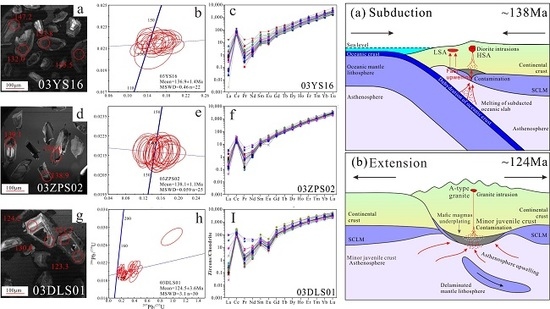Mesozoic High- and Low-SiO2 Adakites and A-Type Granites in the Lower Yangtze River Belt, Eastern China: Implications for Petrogenesis and Metallogeny
Abstract
:1. Introduction
2. Geological Setting and Samples
3. Analytical Methods
3.1. Whole-Rock Major and Trace Element Analysis
3.2. LA-ICPMS Zircon U-Pb Dating
3.3. Zircon Lu-Hf Isotope Analysis
3.4. Zircon Trace Element Analysis
4. Results
4.1. Major and Trace Elements
4.2. Zircon Morphology, U-Pb Dating and Trace Element
4.3. Zircon Lu-Hf Isotopes
5. Discussion
5.1. Age and Petrogenesis of Diorites
5.2. Age and Petrogenesis of A-Type Granites
5.3. Tectonic Evolution and Mineralization
6. Conclusions
- (1)
- Adakites from the Anqing orefield can be divided into two groups as LSA and HSA, corresponding with the Yueshan and Zongpu diorites, respectively. Subduction-related setting is proposed for the magma genesis and involved the following processes. In the early stage, the HSA formed by slab-melts that reacted with peridotite during ascend through the overlying enriched mantle wedge. Subsequently, melting of a peridotitic overlying enriched mantle wedge whose composition has been modified by reaction with slab-melts occurred. Zircons in the HSA and LSA yield ages of 138 Ma and 136 Ma, respectively. Porphyry copper-gold deposits are closely associated with and genetically related to these adakites.
- (2)
- The A1-type granites are dated at 124 Ma, and their zircon εHf(t) values and geochemical features suggest formation through partial melting of Neoproterozoic crust with minor juvenile input under a back-arc extensional setting associated with the roll-back of Paleo–Pacific plate. The source for U in the associated ore deposit is considered to be the A-type granites and sandstones. The emplacement of A-type granitic intrusion provided the heat and fluids which mobilized and concentrated the U.
- (3)
- The adakites together with A-type granites record a tectonic transition from a compressive to an extensional setting during 138–124 Ma.
Supplementary Materials
Author Contributions
Funding
Acknowledgments
Conflicts of Interest
References
- Chang, Y.F.; Liu, X.P.; Wu, C.Y. The Copper-Iron Belt of the Lower and Middle Reaches of the Changjiang River; Geological Publishing House Press: Beijing, China, 1991; pp. 1–234, (In Chinese with English Abstract). [Google Scholar]
- Pan, Y.M.; Dong, P. The Lower Changjiang (Yangzi/Yangtze River) metallogenic belt, east central China: Intrusion- and wall rock-hosted Cu-Fe-Au, Mo, Zn, Pb, Ag deposits. Ore Geol. Rev. 1999, 15, 177–242. [Google Scholar] [CrossRef]
- Wang, Q.; Wyman, D.A.; Xu, J.F.; Zhao, Z.H.; Jian, P.; Xiong, X.L.; Bao, Z.; Li, C.; Bai, Z. Petrogenesis of Cretaceous adakitic and shoshonitic igneous rocks in the Luzong area, Anhui Province (Eastern China): Implications for geodynamics and Cu-Au mineralization. Lithos 2006, 89, 424–446. [Google Scholar] [CrossRef]
- Ling, M.X.; Wang, F.Y.; Yang, X.Y.; Sun, W.D. Cretaceous magmatism along the Lower Yangtze River, China controlled by ridge subduction. Geochim. Et Cosmochim. Acta 2008, 72, A554. [Google Scholar]
- Xie, G.Q.; Mao, J.W.; Li, X.W.; Duan, C.; Yao, L. Late Mesozoic bimodal volcanic rocks in the Jinniu basin, Middle-Lower Yangtze River Belt (YRB), East China: Age, petrogenesis and tectonic implications. Lithos 2011, 127, 144–164. [Google Scholar] [CrossRef]
- Xie, J.C.; Yang, X.Y.; Sun, W.D.; Du, J.G. Early Cretaceous dioritic rocks in the Tongling region, eastern China: Implications for the tectonic settings. Lithos 2012, 150, 49–61. [Google Scholar] [CrossRef] [Green Version]
- Sun, W.D.; Ling, M.; Chung, S.; Ding, X.; Yang, X.; Liang, H.; Fan, W.; Goldfarb, R.; Yin, Q. Geochemical Constraints on Adakites of Different Origins and Copper Mineralization. J. Geol. 2012, 120, 105–120. [Google Scholar] [CrossRef] [Green Version]
- Li, X.H.; Li, Z.; Li, W.; Wang, X.; Gao, Y. Revisiting the “C-type adakites” of the Lower Yangtze River Belt, central eastern China: In-situ zircon Hf-O isotope and geochemical constraints. Chem. Geol. 2013, 345, 1–15. [Google Scholar] [CrossRef]
- Wang, F.Y.; Liu, S.; Li, S.; Akhtar, S.; He, Y. Zircon U-Pb ages, Hf-O isotopes and trace elements of Mesozoic high Sr/Y porphyries from Ningzhen, eastern China: Constraints on their petrogenesis, tectonic implications and Cu mineralization. Lithos 2014, 200, 299–316. [Google Scholar] [CrossRef]
- Yan, J.; Liu, J.; Li, Q.; Xing, G.; Liu, X.; Xie, J.; Chu, X.; Chen, Z. In situ zircon Hf-O isotopic analyses of late Mesozoic magmatic rocks in the Lower Yangtze River Belt, Central Eastern China: Implications for petrogenesis and geodynamic evolution. Lithos 2015, 227, 57–76. [Google Scholar] [CrossRef]
- Zhou, T.F.; Wang, S.; Fan, Y.; Yuan, F.; Zhang, D.; White, N. A review of the intracontinental porphyry deposits in the Middle-Lower Yangtze River Valley metallogenic belt, Eastern China. Ore Geol. Rev. 2015, 65, 433–456. [Google Scholar] [CrossRef]
- Deng, J.H.; Yang, X.; Li, S.; Gu, H.; Mastoi, A.; Sun, W. Partial melting of subducted paleo-Pacific plate during the early Cretaceous: Constraint from adakitic rocks in the Shaxi porphyry Cu-Au deposit, Lower Yangtze River Belt. Lithos 2016, 262, 651–667. [Google Scholar] [CrossRef]
- Wang, S.W.; Zhou, T.; Yuan, F.; Fan, Y.; Cooke, D.; Zhang, L.; Fu, B.; White, N. Geochemical characteristics of the Shujiadian Cu deposit related intrusion in Tongling: Petrogenesis and implications for the formation of porphyry Cu systems in the Middle-Lower Yangtze River Valley metallogenic belt, eastern China. Lithos 2016, 252, 185–199. [Google Scholar] [CrossRef]
- Gu, H.L.; Yang, X.; Deng, J.; Duan, L.; Liu, L. Geochemical and zircon U-Pb geochronological study of the Yangshan A-type granite: Insights into the geological evolution in south Anhui, Eastern Jiangnan Orogen. Lithos 2017, 284, 156–170. [Google Scholar] [CrossRef]
- Defant, M.J.; Drummond, M.S. Derivation of Some Modern Arc Magmas by Melting of Young Subducted Lithosphere. Nature 1990, 347, 662–665. [Google Scholar] [CrossRef]
- Kay, R.W. Aleutian Magnesian Andesites—Melts From Subducted Pacific Ocean Crust. J. Volcanol. Geotherm. Res. 1978, 4, 117–132. [Google Scholar] [CrossRef]
- Martin, H.; Smithies, R.; Rapp, R.; Moyen, J.; Champion, D. An overview of adakite, tonalite-trondhjemite-granodiorite (TTG), and sanukitoid: Relationships and some implications for crustal evolution. Lithos 2005, 79, 1–24. [Google Scholar] [CrossRef]
- Zhang, Q.; Wang, Y.; Qian, Q.; Yang, J.; Wang, Y.; Zhao, T.; Guo, G. The characteristics and tectonic-metallogenic significance of the adakites in Yanshan period from eastern China. Acta Petrol. Sin. 2001, 17, 236–244, (In Chinese with English Abstract). [Google Scholar]
- Chung, S.L.; Liu, D.; Ji, J.; Chu, M.; Lee, H.; Wen, D.; Lo, C.; Lee, T.; Qian, Q.; Zhang, Q. Adakites from continental collision zones: Melting of thickened lower crust beneath southern Tibet. Geology 2003, 31, 1021–1024. [Google Scholar] [CrossRef]
- Whalen, J.B.; Currie, K.L.; Chappell, B.W. A-Type Granites—Geochemical Characteristics, Discrimination and Petrogenesis. Contrib. Mineral. Petrol. 1987, 95, 407–419. [Google Scholar] [CrossRef]
- Eby, G.N. Chemical Subdivision of the a-Type Granitoids—Petrogenetic and Tectonic Implications. Geology 1992, 20, 641–644. [Google Scholar] [CrossRef]
- Sun, W.D.; Ding, X.; Hu, Y.; Li, X. The golden transformation of the Cretaceous plate subduction in the west Pacific. Earth Planet. Sci. Lett. 2007, 262, 533–542. [Google Scholar] [CrossRef]
- Mao, J.R.; Li, Z.L.; Ye, H.M. Mesozoic tectono-magmatic activities in South China: Retrospect and prospect. Sci. China Earth Sci. 2014, 57, 2853–2877. [Google Scholar] [CrossRef]
- Yang, J.H.; Wu, F.; Chung, S.; Wilde, S.; Chu, M. A hybrid origin for the Qianshan A-type granite, northeast China: Geochemical and Sr-Nd-Hf isotopic evidence. Lithos 2006, 89, 89–106. [Google Scholar] [CrossRef]
- Douce, A.E.P. Generation of metaluminous A-type granites by low-pressure melting of calc-alkaline granitoids. Geology 1997, 25, 743–746. [Google Scholar] [CrossRef]
- Mingram, B.; Trumbull, R.; Littman, S.; Gerstenberger, H. A petrogenetic study of anorogenic felsic magmatism in the Cretaceous Paresis ring complex, Namibia: Evidence for mixing of crust and mantle-derived components. Lithos 2000, 54, 1–22. [Google Scholar] [CrossRef]
- Zhou, T.F.; Yue, S.C.; Yuan, F. Lithogenesis of Diorites and Copper, Gold Mineralization in Yueshan Orefield, Anhui Province; Geological Publishing House: Beijing, China, 2005; pp. 1–186. [Google Scholar]
- Wang, Q.; Xu, J.; Zhao, Z.; Bao, Z.; Xu, W.; Xiong, X. Cretaceous high-potassium intrusive rocks in the Yueshan-Hongzhen area of east China: Adakites in an extensional tectonic regime within a continent. Geochem. J. 2004, 38, 417–434. [Google Scholar] [CrossRef] [Green Version]
- Zhao, Z.F.; Zheng, Y.; Wei, C.; Gong, B. Temporal relationship between granite cooling and hydrothermal uranium mineralization at Dalongshan in China: A combined radiometric and oxygen isotopic study. Ore Geol. Rev. 2004, 25, 221–236. [Google Scholar] [CrossRef]
- Liu, S.A.; Li, S.; He, Y.; Huang, F. Geochemical contrasts between early Cretaceous ore-bearing and ore-barren high-Mg adakites in central-eastern China: Implications for petrogenesis and Cu-Au mineralization. Geochim. Et Cosmochim. Acta 2010, 74, 7160–7178. [Google Scholar] [CrossRef]
- Yang, Y.Z.; Chen, F.; Siebel, W.; Zhang, H.; Long, Q.; He, J.; Hou, Z.; Zhu, X. Age and composition of Cu-Au related rocks from the lower Yangtze River belt: Constraints on paleo-Pacific slab roll-back beneath eastern China. Lithos 2014, 202, 331–346. [Google Scholar] [CrossRef]
- Xing, F.M.; Xu, X. High-potassium calc-alkaline intrusive rocks in Tongling area, Anhui province. Geochimica 1996, 25, 29–38, (In Chinese with English Abstract). [Google Scholar]
- Zhang, L.J.; Zhou, T.; Yuan, F.; Fan, Y.; Cooke, D. Petrogenetic-metallogenetic setting and temporal-spatial framework of the Yueshan district, Anhui Province, east-central China. Int. Geol. Rev. 2011, 53, 542–561. [Google Scholar] [CrossRef]
- Mao, J.W.; Xie, G.; Duan, C.; Pirajno, F.; Ishiyama, D.; Chen, Y. A tectono-genetic model for porphyry-skarn-stratabound Cu-Au-Mo-Fe and magnetite-apatite deposits along the Middle-Lower Yangtze River Valley, Eastern China. Ore Geol. Rev. 2011, 43, 294–314. [Google Scholar] [CrossRef]
- Xing, F.M.; Xu, X.; Li, Z.C. Discovery of the Early Proterozoic Basement in the Middle-Lower Reaches of Yangtze-River and Its Significance. Chin. Sci. Bull. 1994, 39, 135–139. [Google Scholar]
- Zhou, T.F.; Yuan, F.; Yue, S.; Liu, X.; Zhang, X.; Fan, Y. Geochemistry and evolution of ore-forming fluids of the Yueshan Cu-Au skarn- and vein-type deposits, Anhui Province, South China. Ore Geol. Rev. 2007, 31, 279–303. [Google Scholar] [CrossRef]
- Anhui, R.G.S. Regional Geology of Anhui Province; Geological Publishing House: Beijing, China, 1987; pp. 1–721. [Google Scholar]
- Wiedenbeck, M.; Alle, P.; Griffin, W. Three Natural Zircon Standards for U-TH-PB, LU-HF, trace element and ree analyses. Geostand. Newslett. 1995, 19, 1–23. [Google Scholar] [CrossRef]
- Andersen, T. Correction of common lead in U-Pb analyses that do not report Pb-204. Chem. Geol. 2002, 192, 59–79. [Google Scholar] [CrossRef]
- Ludwig, K.R. ISOPLOT 3.00: A Geochronological Toolkit for Microsoft Excel; Berkeley Geochronology Center: Berkeley, CA, USA, 2003; pp. 1–39. [Google Scholar]
- Wu, F.Y.; Yang, Y.; Xie, L.; Yang, J.; Xu, P. Hf isotopic compositions of the standard zircons and baddeleyites used in U-Pb geochronology. Chem. Geol. 2006, 234, 105–126. [Google Scholar] [CrossRef]
- Scherer, E.; Munker, C.; Mezger, K. Calibration of the lutetium-hafnium clock. Science 2001, 293, 683–687. [Google Scholar] [CrossRef] [PubMed]
- BlichertToft, J.; Albarede, F. The Lu-Hf isotope geochemistry of chondrites and the evolution of the mantle-crust system. Earth Planet. Sci. Lett. 1997, 148, 243–258. [Google Scholar] [CrossRef]
- Griffin, W.L.; Pearson, N.; Belousova, E. The Hf isotope composition of cratonic mantle: LAM-MC-ICPMS analysis of zircon megacrysts in kimberlites. Geochim. Et Cosmochim. Acta 2000, 64, 133–147. [Google Scholar] [CrossRef]
- Griffin, W.L.; Wang, X.; Jackson, S. Zircon chemistry and magma mixing, SE China: In-situ analysis of Hf isotopes, Tonglu and Pingtan igneous complexes. Lithos 2002, 61, 237–269. [Google Scholar] [CrossRef]
- Liu, Y.C.; Gu, X.; Li, S.; Hou, Z.; Song, B. Multistage metamorphic events in granulitized eclogites from the North Dabie complex zone, central China: Evidence from zircon U-Pb age, trace element and mineral inclusion. Lithos 2011, 122, 107–121. [Google Scholar] [CrossRef]
- Yuan, H.L.; Gao, S.; Liu, X.; Li, H.; Gunther, D. Accurate U-Pb age and trace element determinations of zircon by laser ablation-inductively coupled plasma-mass spectrometry. Geostand. Geoanal. Res. 2004, 28, 353–370. [Google Scholar] [CrossRef]
- Zhang, B.T.; Zhang, F.; Ni, Q.; Chen, P.; Ze, J.; Shen, W. Geology and Geochemical Characteristics of the Anqing-Lujiang Quartz Syenite Rock-belt and its Genesis. Acta Petrol. Sin. 1988, 3, 1–14, (In Chinese with English Abstract). [Google Scholar]
- Qiu, R.L. Petrological characteristics and genesis of High-K diorite in Yueshan, Anhui province. Geol. Rev. 1992, 38, 97–108, (In Chinese with English Abstract). [Google Scholar]
- Zhou, T.F.; Yue, S.; Yuan, F.; Liu, X. A discussion on petrological characteristics and genesis of Yueshan intrusion, Anhui Province. Geol. J. China Univ. 2001, 7, 70–80, (In Chinese with English Abstract). [Google Scholar]
- Yang, G.S.; Wen, H.; Hu, R.; Yu, W.; Fan, H. Petro-geochemical charactristics and genesis of Yueshan intrusion, Anhui province. Acta Mineral. Sin. 2007, 27, 406–413, (In Chinese with English Abstract). [Google Scholar]
- Xu, F.M.; Du, Y.; Wang, G.; Gao, Y.; Dong, Q.; Fang, F. Zircon SHRIMP U-Pb ages, geochemical characteristics and geological implication of Yueshan complex, Anhui province, China. J. Mineral. Petrol. 2012, 32, 61–66, (In Chinese with English Abstract). [Google Scholar]
- Wilson, M. Igneous Petrogenesis: A Global Tectonic Approach; Unwin and Hyman: London, UK, 1989; pp. 1–466. [Google Scholar]
- Peccerillo, A.; Taylor, S.R. Geochemistry of Eocene calc-alkaline volcanic rocks from the Kastamonu area, Northern Turkey. Contrib. Mineral. Petrol. 1976, 58, 63–81. [Google Scholar] [CrossRef]
- Mcdonough, W.F.; Sun, S.S. The Composition of the Earth. Chem. Geol. 1995, 120, 223–253. [Google Scholar] [CrossRef]
- Watson, E.B.; Harrison, T.M. Zircon saturation revisited: Temperature and composition effects in a variety of crustal magma types. Earth Planet. Sci. Lett. 1983, 64, 295–304. [Google Scholar] [CrossRef]
- Hofmann, A.W. Chemical Differentiation of the Earth—The Relationship Between Mantle, Continental-Crust, and Oceanic-Crust. Earth Planet. Sci. Lett. 1988, 90, 297–314. [Google Scholar] [CrossRef]
- Gao, S.; Luo, T.; Zhang, B.; Zhang, H.; Han, Y.; Zhao, Z.; Hu, Y. Chemical composition of the continental crust as revealed by studies in East China. Geochim. Et Cosmochim. Acta 1998, 62, 1959–1975. [Google Scholar] [CrossRef]
- Hoskin, P.W.O.; Black, L.P. Metamorphic zircon formation by solid-state recrystallization of protolith igneous zircon. J. Metamorph. Geol. 2000, 18, 423–439. [Google Scholar] [CrossRef]
- Watson, E.B.; Wark, D.A.; Thomas, J.B. Crystallization thermometers for zircon and rutile. Contrib. Mineral. Petrol. 2006, 151, 413–433. [Google Scholar] [CrossRef]
- Chen, J.F.; Li, X.; Zhou, T.; Foland, K. 40Ar/39Ar dating for the Yueshan diorite, Anhui provice and the estimated formation time of the associated ore deposit. Geoscience 1991, 5, 91–99, (In Chinese with English Abstract). [Google Scholar]
- Li, B.; Chen, J.; Zheng, Y.; Zhao, Z.; Qian, H. Relationship among oxygen isotope, Rb-Sr isochron and mineral alteration in quartz diorite at Yueshan in Anhui. Acta Petrol. Sin. 2004, 20, 1185–1192. [Google Scholar]
- Wu, F.Y.; Ji, W.; Sun, D.; Yang, Y.; Li, X. Zircon U-Pb geochronology and Hf isotopic compositions of the Mesozoic granites in southern Anhui Province, China. Lithos 2012, 150, 6–25. [Google Scholar] [CrossRef]
- Wang, Q.; McDermott, F.; Xu, J. Cenozoic K-rich adakitic volcanic rocks in the Hohxil area, northern Tibet: Lower-crustal melting in an intracontinental setting. Geology 2005, 33, 465–468. [Google Scholar] [CrossRef]
- Richards, J.R.; Kerrich, R. Special paper: Adakite-like rocks: Their diverse origins and questionable role in metallogenesis. Econ. Geol. 2007, 102, 537–576. [Google Scholar] [CrossRef]
- Kamei, A.; Miyake, Y.; Owada, M.; Kimura, J. A pseudo adakite derived from partial melting of tonalitic to granodioritic crust, Kyushu, southwest Japan arc. Lithos 2009, 112, 615–625. [Google Scholar] [CrossRef]
- Xu, J.F.; Shinjo, R.; Defant, M.; Wang, Q.; Rapp, R. Origin of Mesozoic adakitic intrusive rocks in the Ningzhen area of east China: Partial melting of delaminated lower continental crust? Geology 2002, 30, 1111–1114. [Google Scholar] [CrossRef]
- Rapp, R.P.; Shimizu, N.; Norman, M.; Applegate, G. Reaction between slab-derived melts and peridotite in the mantle wedge: Experimental constraints at 3.8 GPa. Chem. Geol. 1999, 160, 335–356. [Google Scholar] [CrossRef]
- Chen, J.F.; Zhou, T.; Li, X.; Foland, K.; Huang, C.; Lu, W. Sr and Nd isotopic constraints on source regions of the intermediate and acid intrusions from southern Anhui province. Geochemistry 1993, 3, 261–268. [Google Scholar]
- Defant, M.J.; Kepezhinskas, P. Evidence suggests slab melting in arc magmas. Trans. Am. Geophys. Union 2001, 82, 65–69. [Google Scholar] [CrossRef]
- Wang, Q.; Wyman, D.; Xu, J.; Jian, P.; Zhao, Z.; Li, C.; Xu, W.; Ma, J.; He, B. Early Cretaceous adakitic granites in the Northern Dabie Complex, central China: Implications for partial melting and delamination of thickened lower crust. Geochim. Et Cosmochim. Acta 2007, 71, 2609–2636. [Google Scholar] [CrossRef]
- He, Y.S.; Li, S.; Hoefs, J.; Huang, F.; Liu, S.; Hou, Z. Post-collisional granitoids from the Dabie orogen: New evidence for partial melting of a thickened continental crust. Geochim. Et Cosmochim. Acta 2011, 75, 3815–3838. [Google Scholar] [CrossRef]
- Guo, F.; Fan, W.M.; Li, C.W. Geochemistry of late Mesozoic adakites from the Sulu belt, eastern China: Magma genesis and implications for crustal recycling beneath continental collisional orogens. Geol. Mag. 2006, 143, 1–13. [Google Scholar] [CrossRef]
- Yan, J.; Chen, J.F.; Xu, X.S. Geochemistry of Cretaceous mafic rocks from the Lower Yangtze region, eastern China: Characteristics and evolution of the lithospheric mantle. J. Asian Earth Sci. 2008, 33, 177–193. [Google Scholar] [CrossRef]
- Hofmann, A.W. Sampling mantle heterogeneity through oceanic basalts: Isotopes and trace elements. In The Mantle and Core. Treatise on Geochemistry; Carlson, R.W., Ed.; Elservier-Pergamon: Oxford, UK, 2003; pp. 61–101. [Google Scholar]
- Jahn, B.M.; Wu, F.; Lo, C.; Tsan, C. Crust-mantle interaction induced by deep subduction of the continental crust: Geochemical and Sr-Nd isotopic evidence from post-collisional mafic-ultramafic intrusions of the northern Dabie complex, central China. Chem. Geol. 1999, 157, 119–146. [Google Scholar] [CrossRef]
- Ballard, J.R.; Palin, J.M.; Campbell, I.H. Relative oxidation states of magmas inferred from Ce(IV)/Ce(III) in zircon: Application to porphyry copper deposits of Northern Chile. Contrib. Mineral. Petrol. 2002, 144, 347–364. [Google Scholar] [CrossRef]
- Li, S.; Yang, X.; Huang, Y.; Sun, W. Petrogenesis and mineralization of the Fenghuangshan skarn Cu-Au deposit, Tongling ore cluster field, Lower Yangtze metallogenic belt. Ore Geol. Rev. 2014, 58, 148–162. [Google Scholar] [CrossRef]
- Tang, M.; Wang, X.; Xu, X.; Zhu, C.; Cheng, T.; Yu, Y. Neoproterozoic subducted materials in the generation of Mesozoic Luzong volcanic rocks: Evidence from apatite geochemistry and Hf-Nd isotopic decoupling. Gondwana Res. 2012, 21, 266–280. [Google Scholar] [CrossRef]
- Sun, W.H.; Zhou, M.; Gao, J.; Yang, Y.; Zhao, X.; Zhao, J. Detrital zircon U-Pb geochronological and Lu-Hf isotopic constraints on the Precambrian magmatic and crustal evolution of the western Yangtze Block, SW China. Precambrian Res. 2009, 172, 99–126. [Google Scholar] [CrossRef]
- Xing, F.M.; Xu, X. Two A-type granite belts from Anhui. Acta Mineral. Sin. 1994, 10, 357–369, (In Chinese with English Abstract). [Google Scholar]
- Frost, B.R.; Barnes, C.; Collins, W.; Arculus, R.; Ellise, D.; Frost, C. A geochemical classification for granitic rocks. J. Petrol. 2001, 42, 2033–2048. [Google Scholar] [CrossRef]
- Frost, C.D.; Frost, B.R. On Ferroan (A-type) Granitoids: Their Compositional Variability and Modes of Origin. J. Petrol. 2011, 52, 39–53. [Google Scholar] [CrossRef]
- Turner, S.P.; Foden, J.D.; Morrison, R.S. Derivation of Some a-Type Magmas by Fractionation of Basaltic Magma—An Example from the Padthaway Ridge, South Australia. Lithos 1992, 28, 151–179. [Google Scholar] [CrossRef]
- Wong, J.; Sun, M.; Xing, G.; Li, X.; Zhao, G.; Wong, K.; Yuan, C.; Xia, X.; Li, L.; Wu, F. Geochemical and zircon U-Pb and Hf isotopic study of the Baijuhuajian metaluminous A-type granite: Extension at 125–100 Ma and its tectonic significance for South China. Lithos 2009, 112, 289–305. [Google Scholar] [CrossRef]
- Jiang, Y.; Zhao, P.; Zhou, Q.; Liao, S.; Jin, G. Petrogenesis and tectonic implications of Early Cretaceous S- and A-type granites in the northwest of the Gan-Hang rift, SE China. Lithos 2011, 121, 55–73. [Google Scholar] [CrossRef]
- Richards, J.P. Postsubduction porphyry Cu-Au and epithermal Au deposits: Products of remelting of subduction-modified lithosphere. Geology 2009, 37, 247–250. [Google Scholar]
- Richards, J.P. Magmatic to hydrothermal metal fluxes in convergent and collided margins. Ore Geol. Rev. 2011, 40, 1–26. [Google Scholar]
- Mao, J.W.; Wang, Y.; Lehmann, B.; Yu, J.; Du, A.; Mei, Y. Molybdenite Re-Os and albite Ar-40/Ar-39 dating of Cu-Au-Mo and magnetite porphyry systems in the Yangtze River valley and metallogenic implications. Ore Geol. Rev. 2006, 29, 307–324. [Google Scholar] [CrossRef]
- Brandon, A.D.; Draper, D.S. Constraints on the origin of the oxidation state of mantle overlying subduction zones: An example from Simcoe, Washington, USA. Geochim. Et Cosmochim. Acta 1996, 60, 1739–1749. [Google Scholar] [CrossRef]
- Sun, W.D.; Liang, H.; Ling, M.; Zhan, M.; Ding, X.; Zhang, H.; Yang, X.; Li, Y.; Ireland, T.; Wei, Q.; et al. The link between reduced porphyry copper deposits and oxidized magmas. Geochim. Et Cosmochim. Acta 2013, 103, 263–275. [Google Scholar] [CrossRef] [Green Version]
- Sun, W.D.; Zhang, H.; Ling, M.; Ding, X.; Chung, S.; Zhou, J.; Yang, X.; Fan, W. The genetic association of adakites and Cu-Au ore deposits. Int. Geol. Rev. 2011, 53, 691–703. [Google Scholar] [CrossRef]
- Moghadam, H.S.; Rossetti, F.; Lucci, F.; Chiaradia, M.; Gerdes, A.; Martinez, M.; Ghorbani, G.; Nasrabady, M. The calc-alkaline and adakitic volcanism of the Sabzevar structural zone (NE Iran): Implications for the Eocene magmatic flare-up in Central Iran. Lithos 2016, 248, 517–535. [Google Scholar] [CrossRef]
- Rossetti, F.; Nasrabady, M.; Theye, T.; Gerdes, A.; Monie, P.; Lucci, F.; Vignaroli, G. Adakite differentiation and emplacement in a subduction channel: The late Paleocene Sabzevar magmatism (NE Iran). Geol. Soc. Am. Bull. 2014, 126, 317–343. [Google Scholar] [CrossRef] [Green Version]
- Min, M.Z.; Luo, X.; Du, G.; He, B.; Campbell, A. Mineralogical and geochemical constraints on the genesis of the granite-hosted Huangao uranium deposit, SE China. Ore Geol. Rev. 1999, 14, 105–127. [Google Scholar] [CrossRef]
- Deng, G.R. A brief analysis of geological features of the Dalongshan uranium ore deposit formation in Anqing. Geol. Anhui 2017, 27, 95–98, (In Chinese with English Abstract). [Google Scholar]
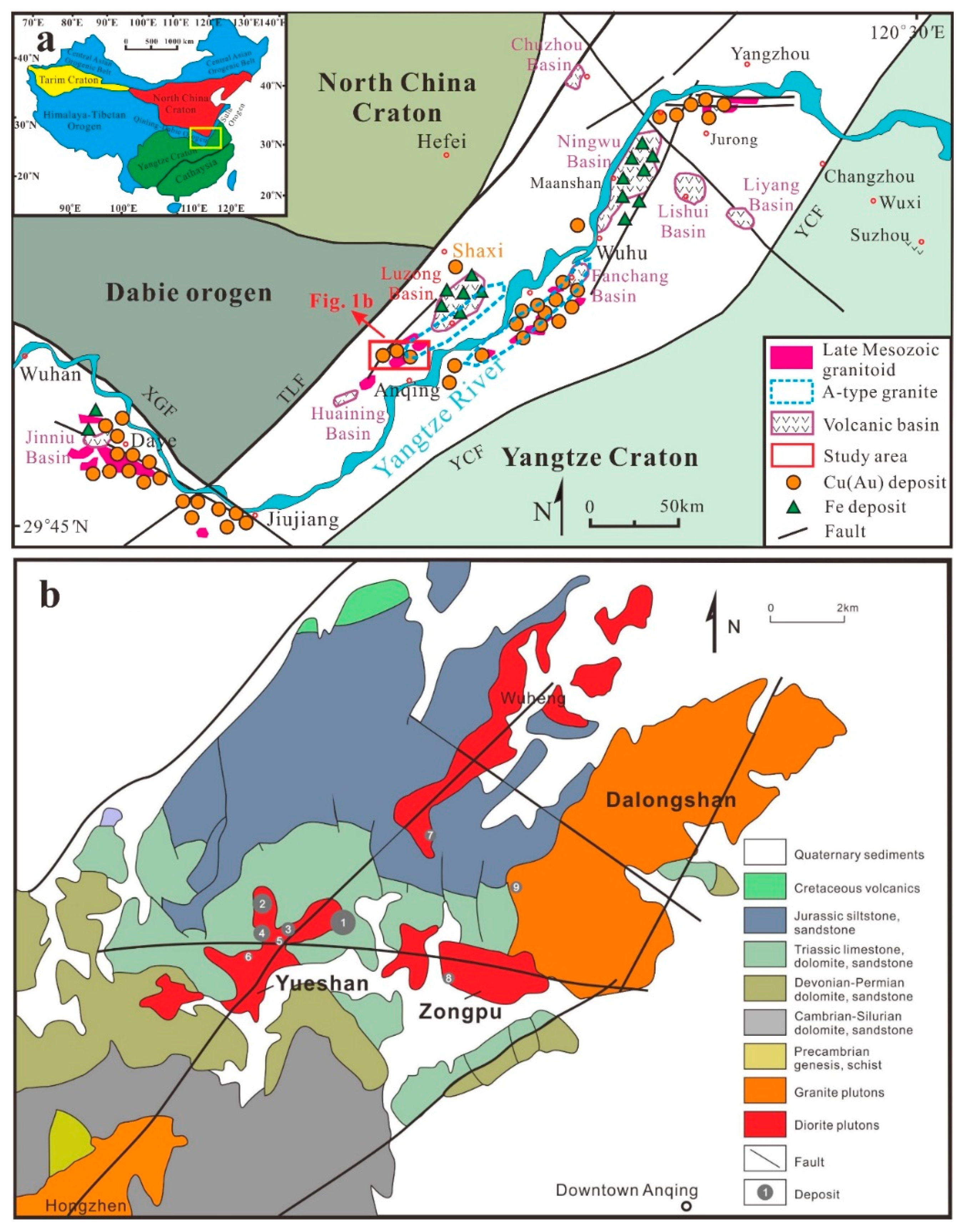

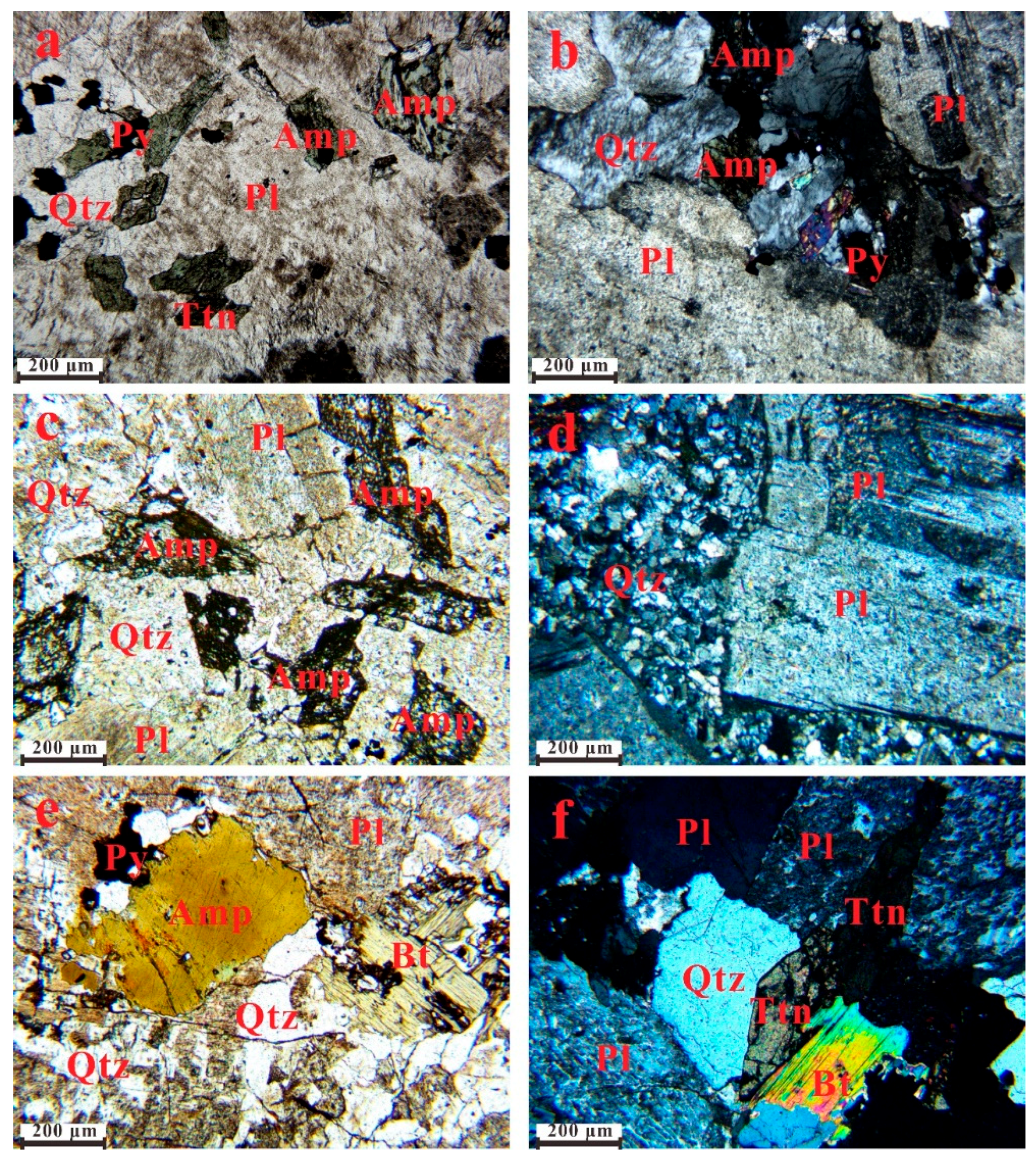
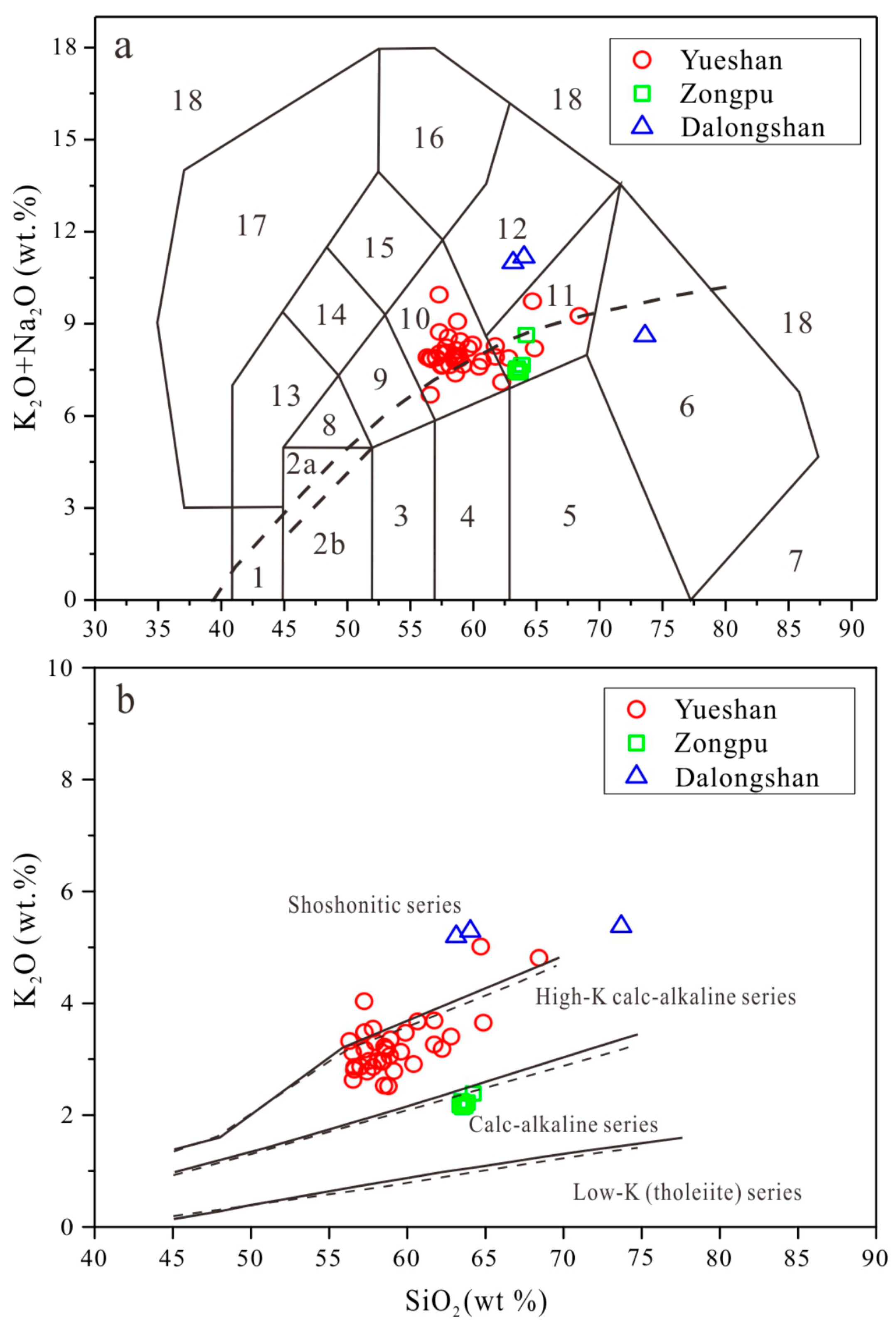
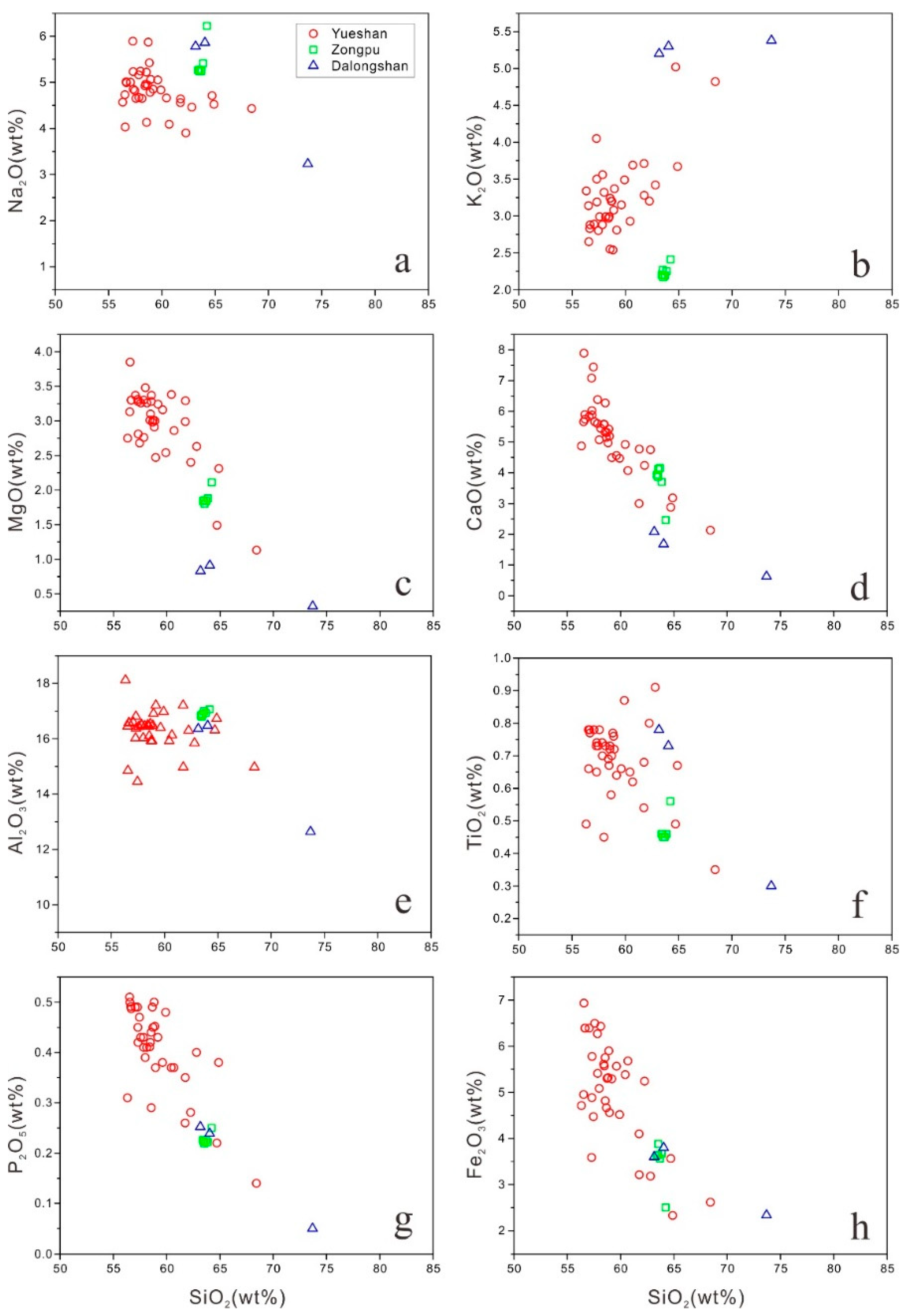
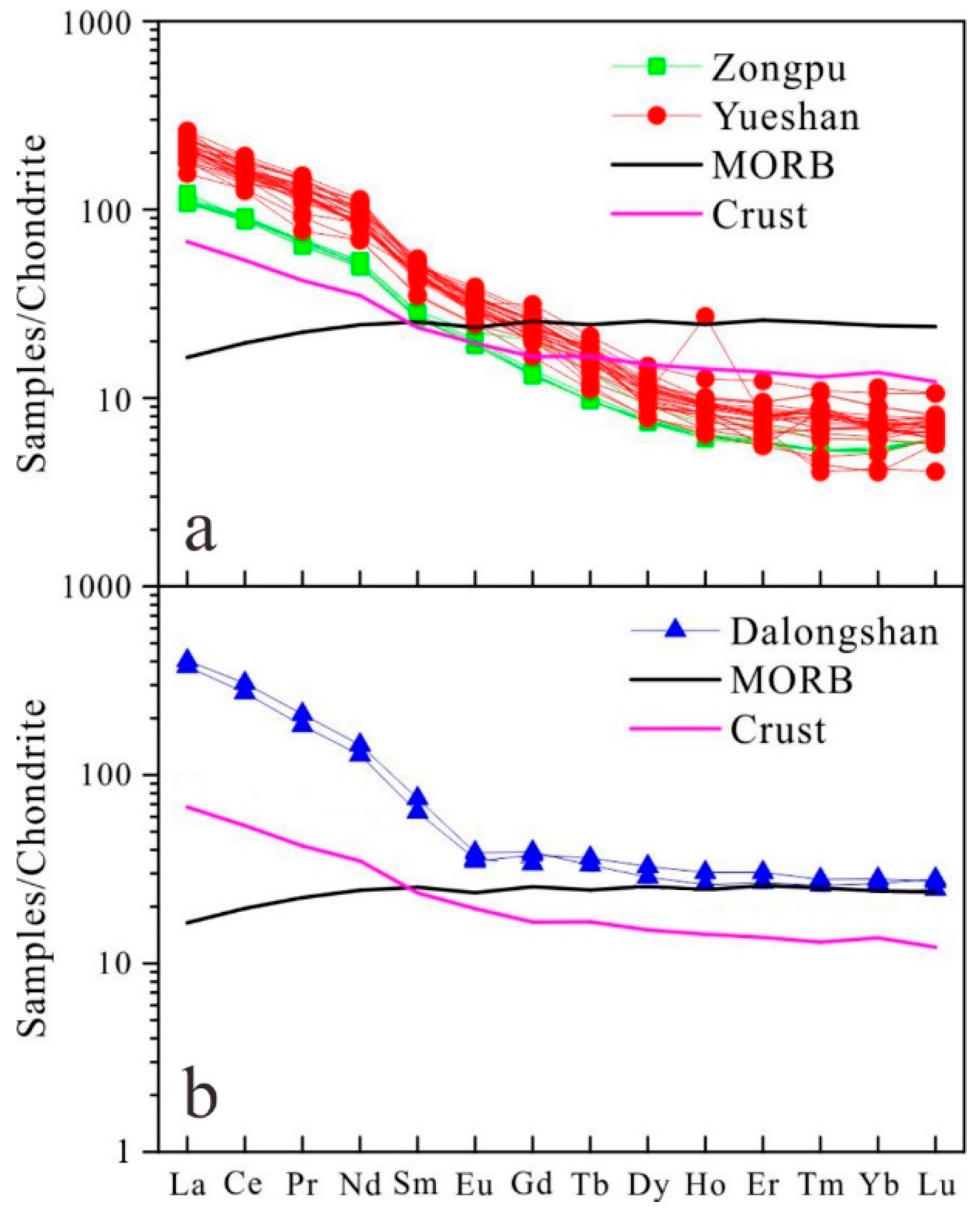
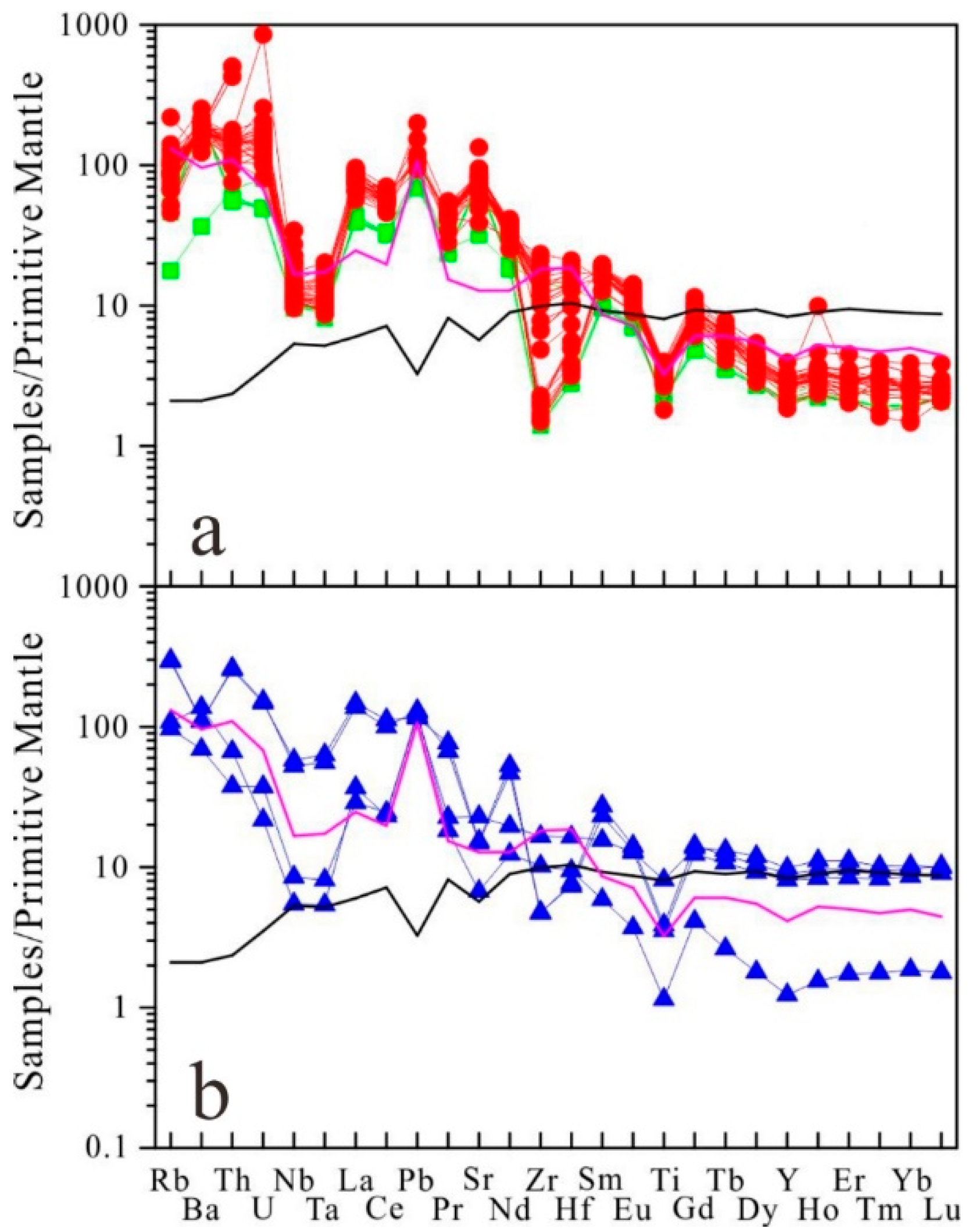
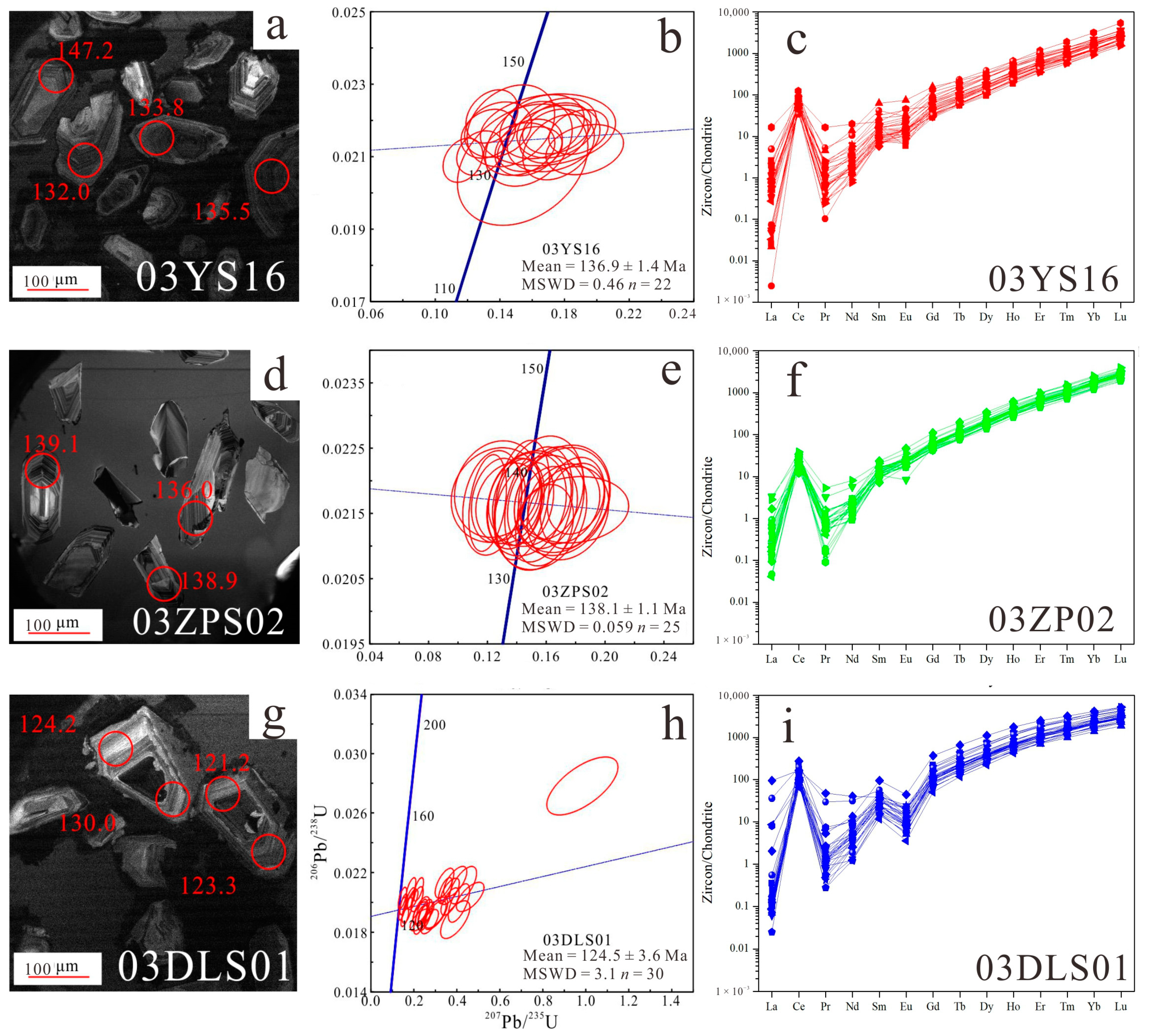
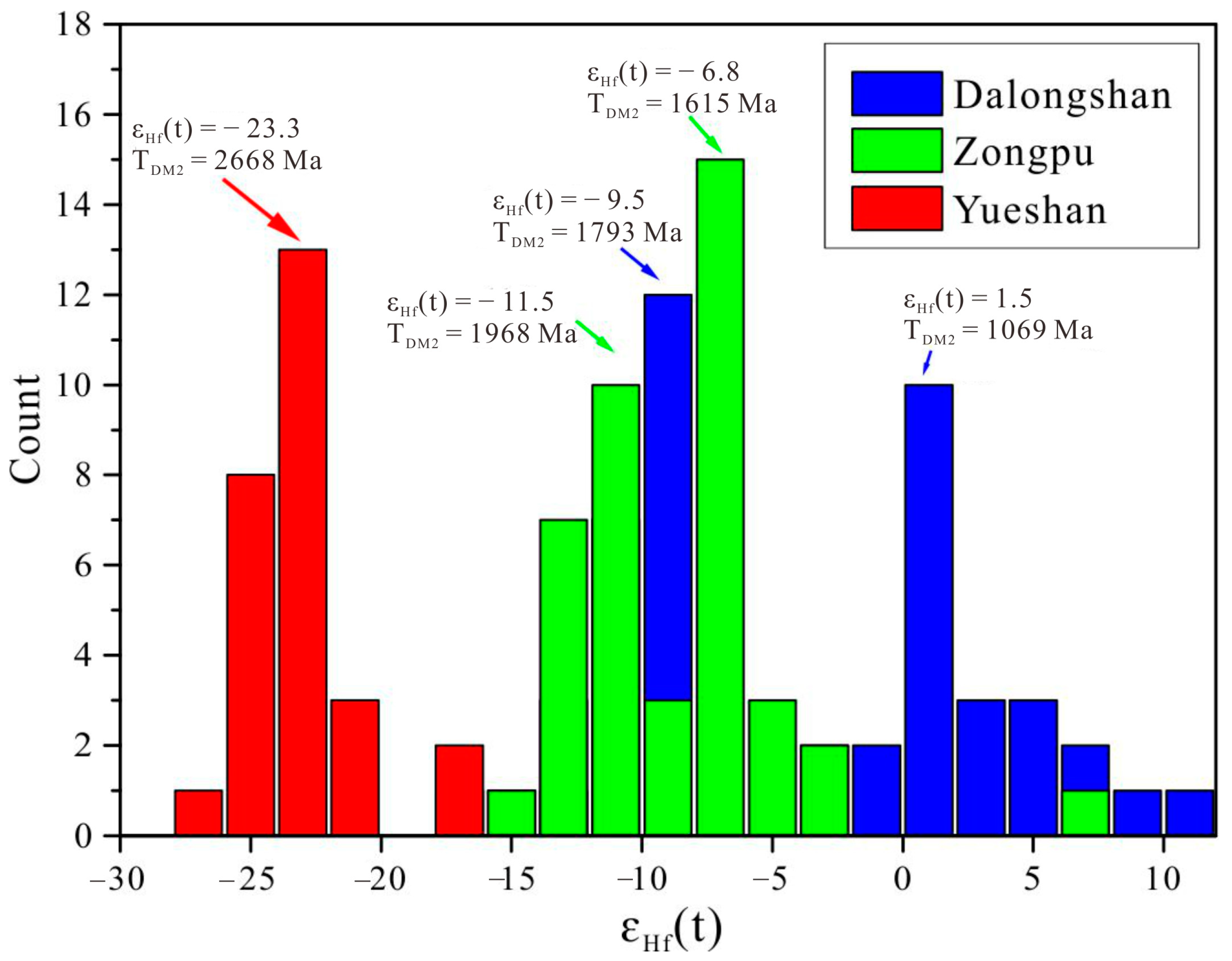
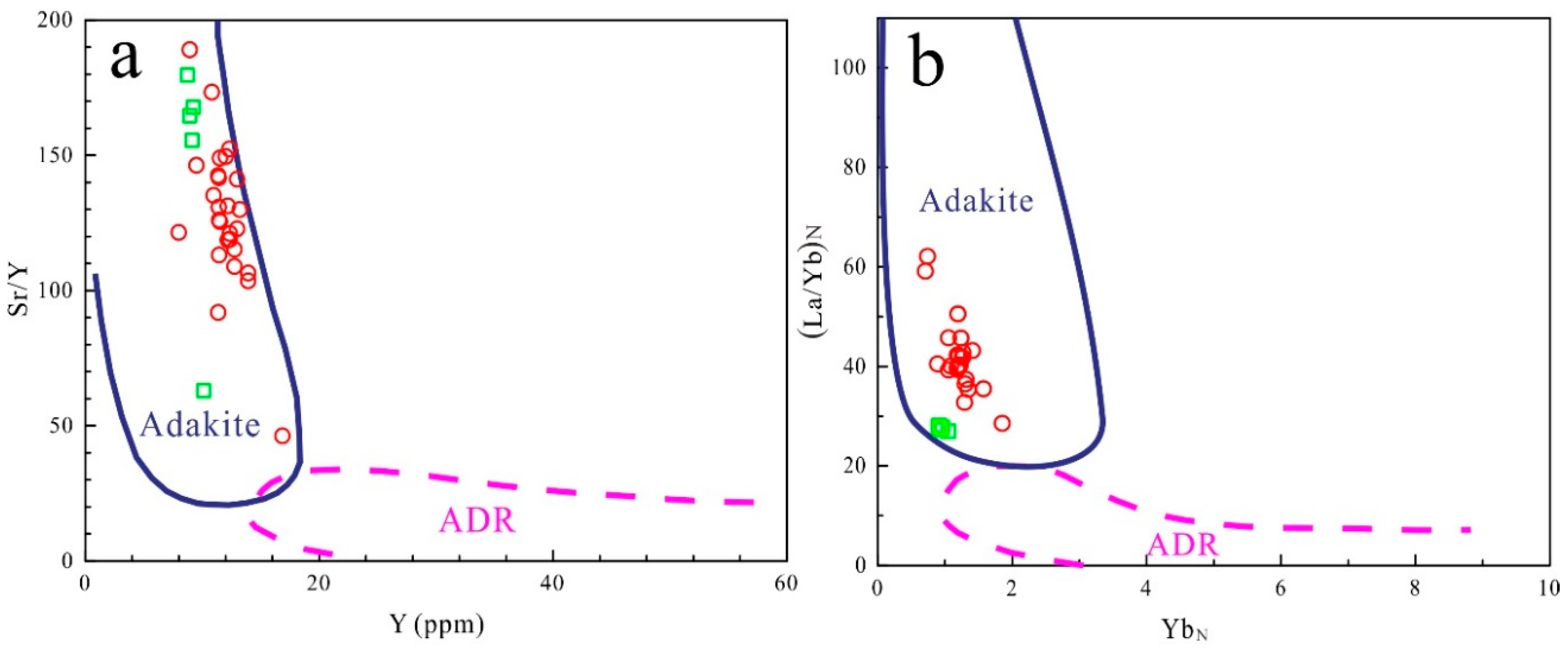
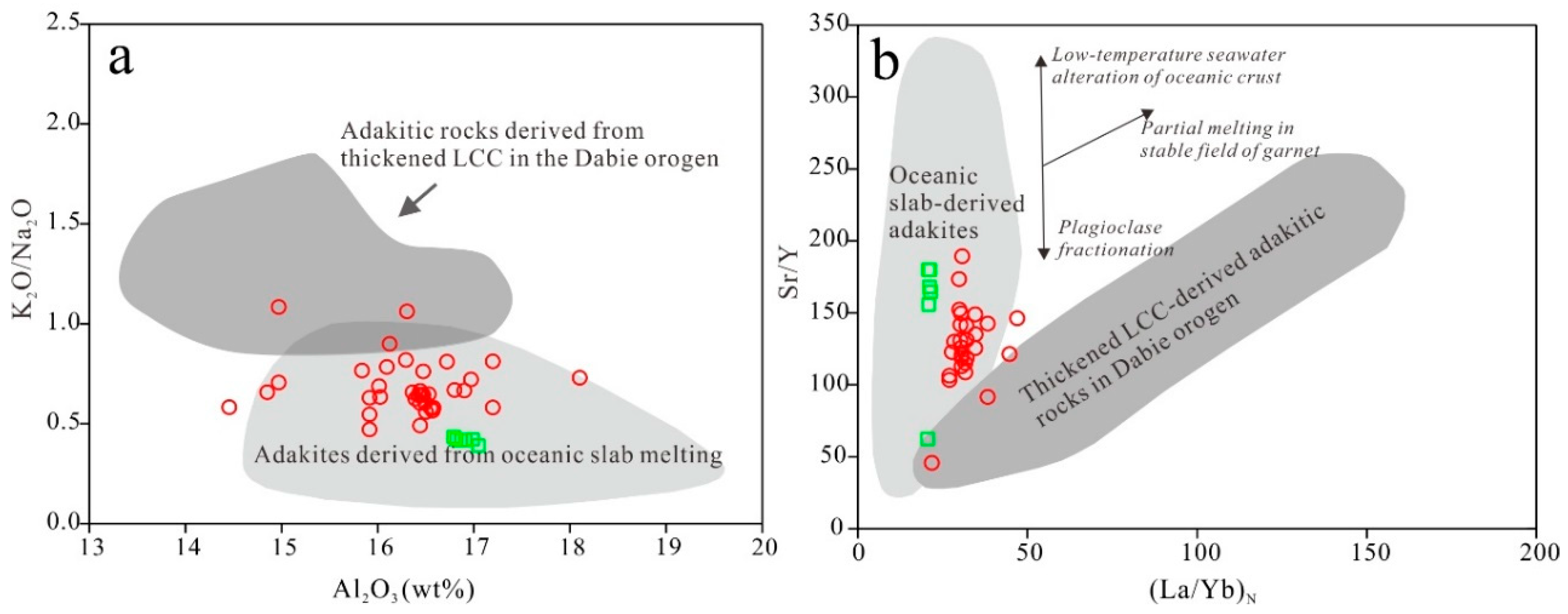
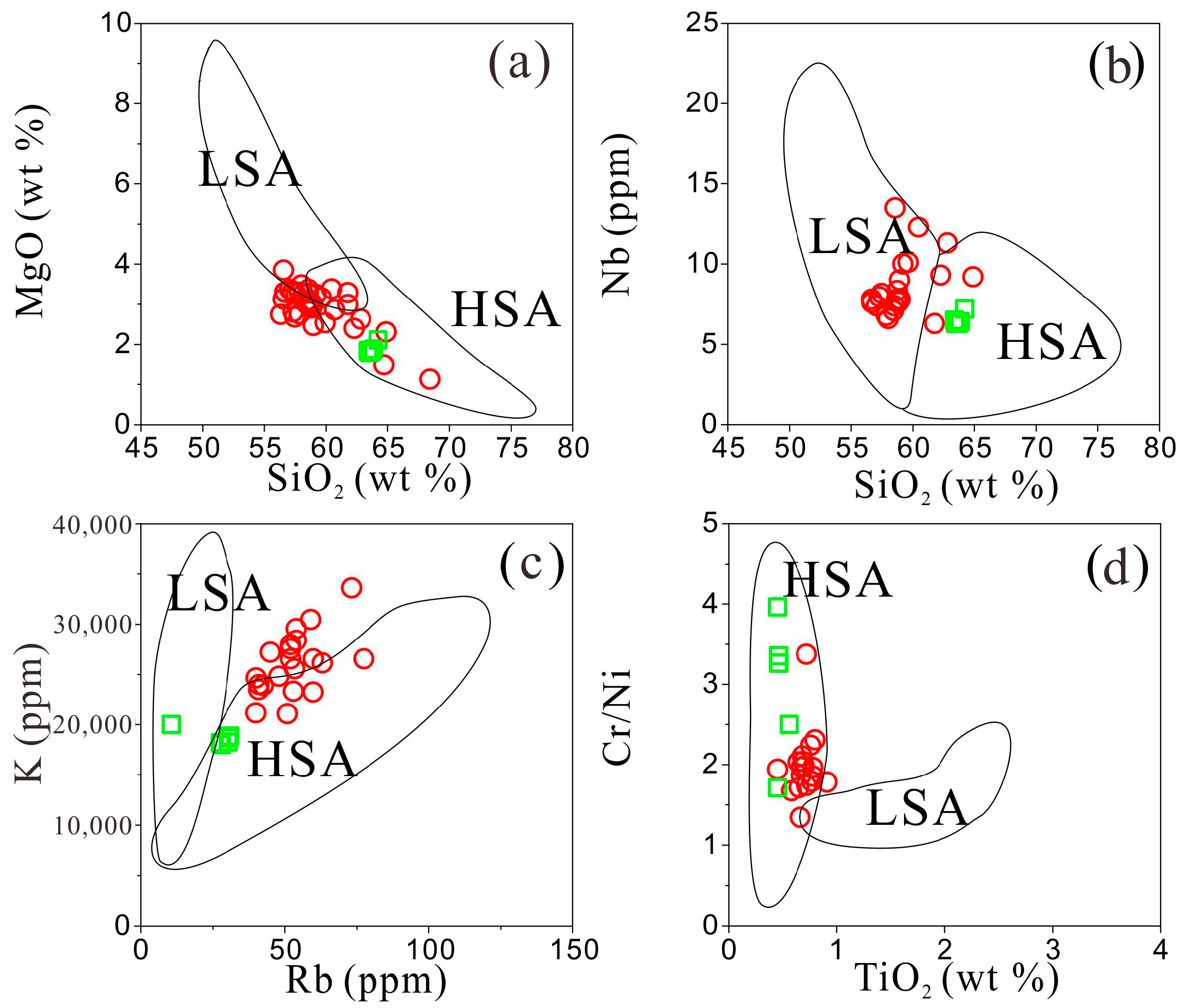
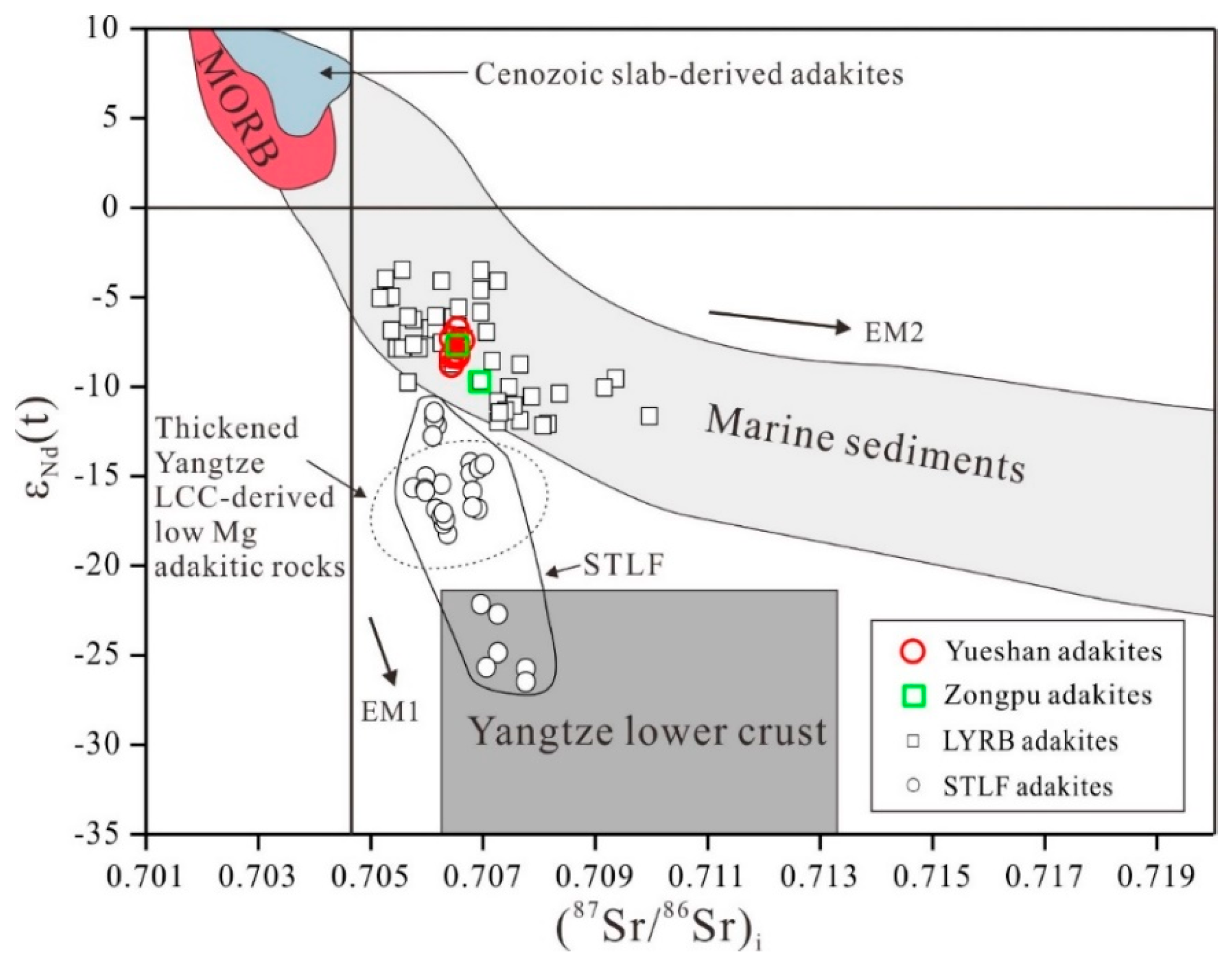
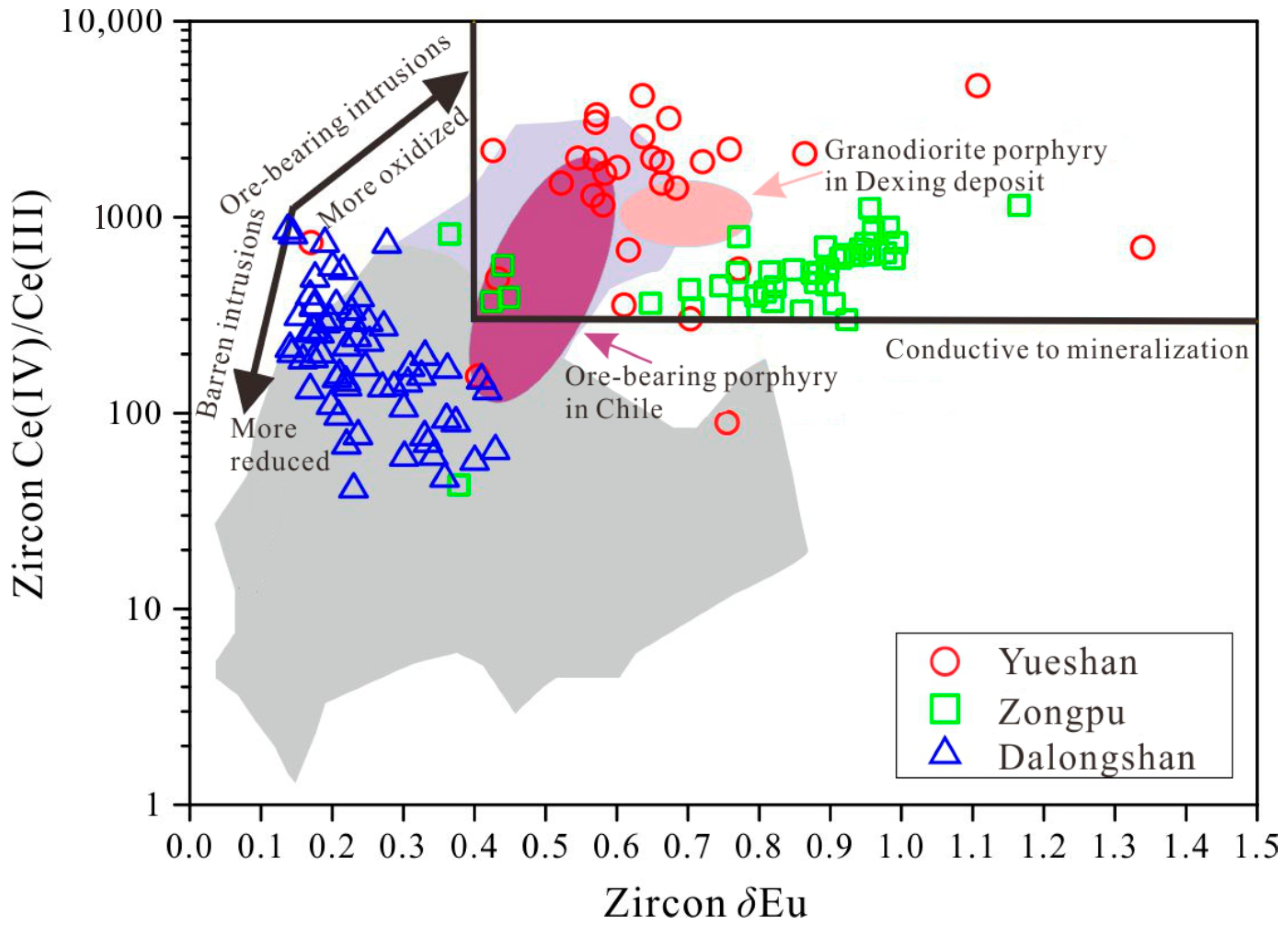
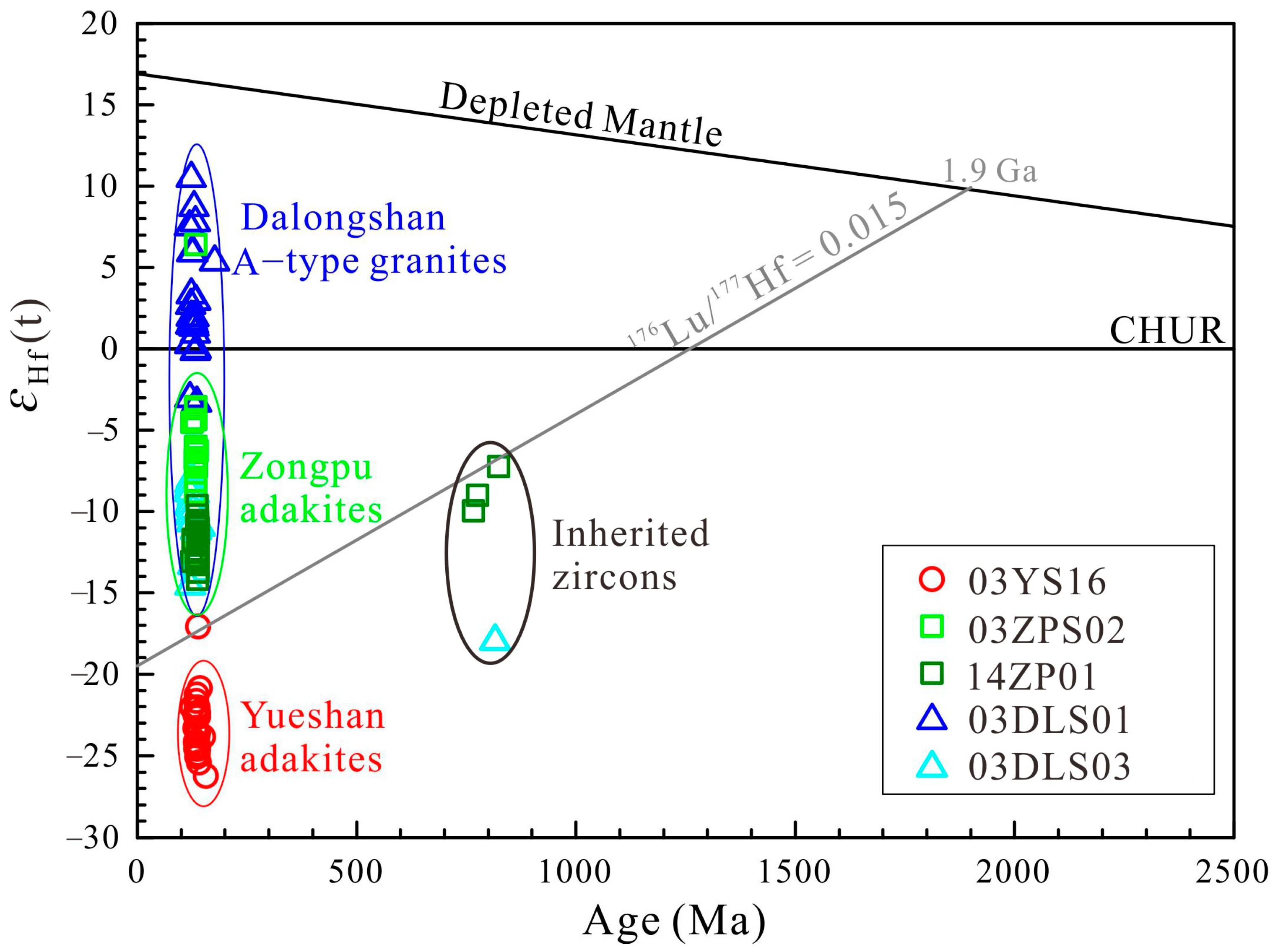
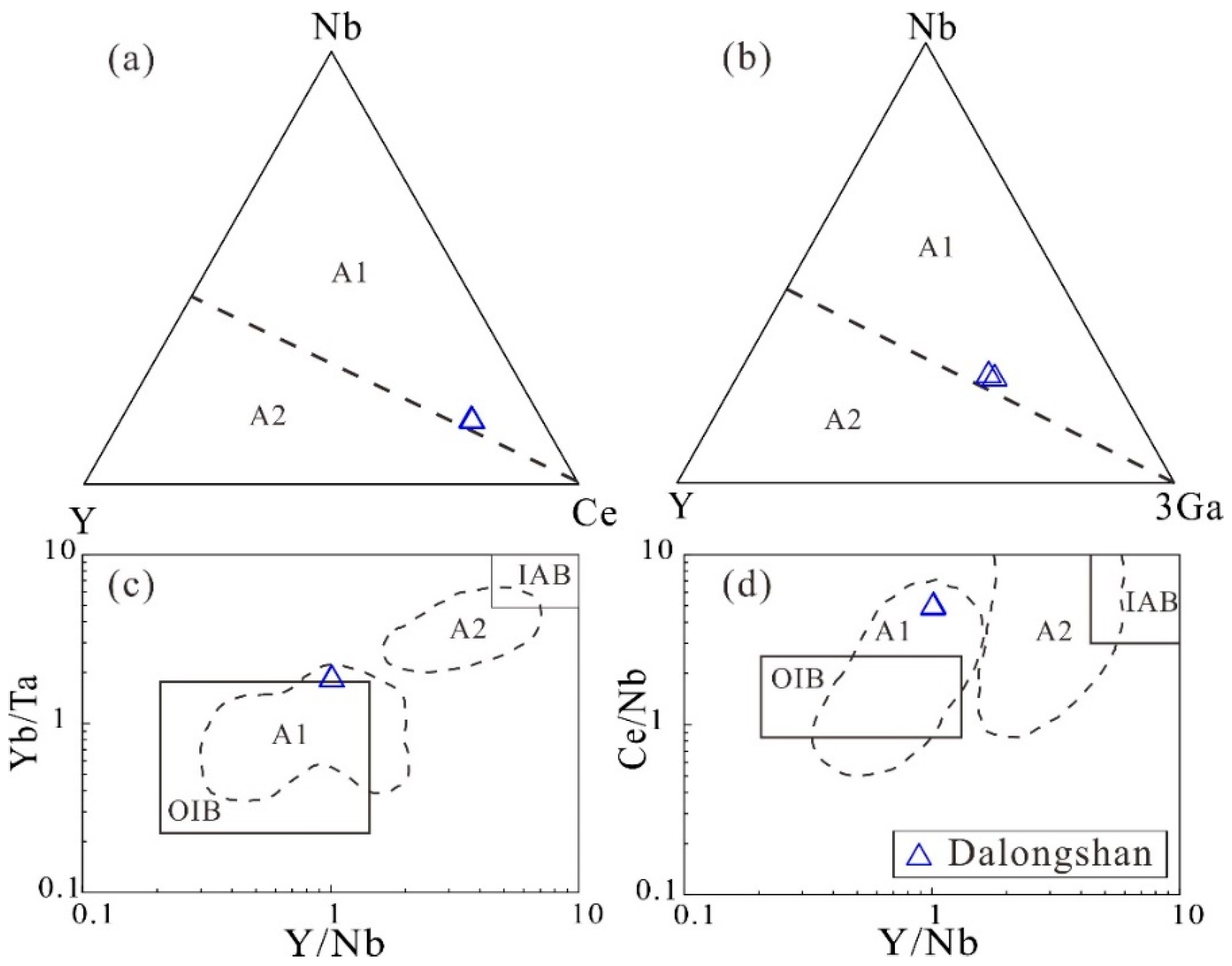
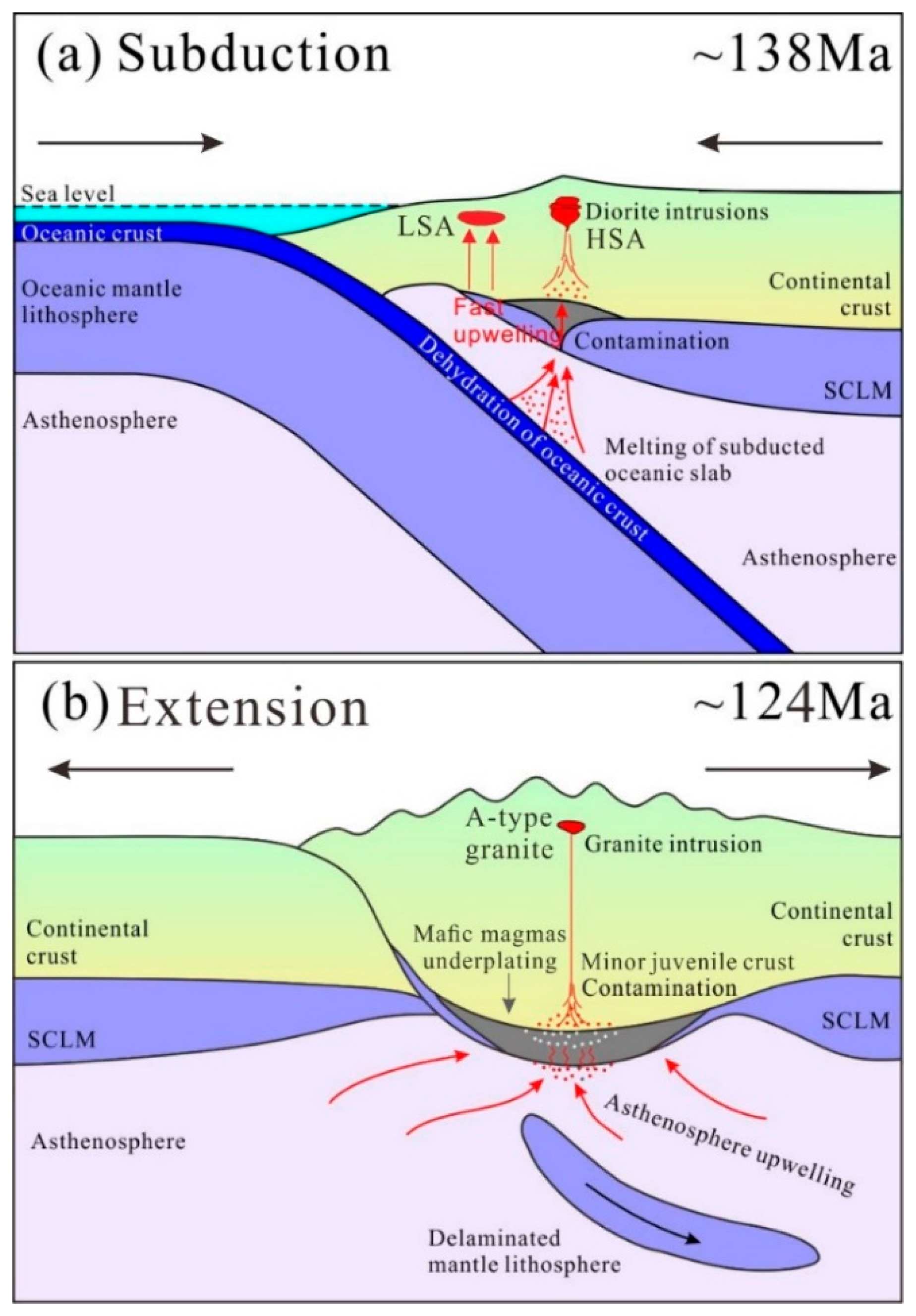
| Samples | YS18 | 14YS01 | 14YS02 | 14YS03 | 14YS04 | 14YS05 | 14YS06 | 03ZPS02 | 14ZP01 | 14ZP02 | 14ZP03 | 14ZP04 | 14ZP05 | 14DLS01 | 14DLS02 |
|---|---|---|---|---|---|---|---|---|---|---|---|---|---|---|---|
| Intrusion | Yueshan | Yueshan | Yueshan | Yueshan | Yueshan | Yueshan | Yueshan | Zongpu | Zongpu | Zongpu | Zongpu | Zongpu | Zongpu | Dalongshan | Dalongshan |
| Major oxides (wt %) | |||||||||||||||
| SiO2 | 62.26 | 57.06 | 58.43 | 58.91 | 58.49 | 56.68 | 56.66 | 64.23 | 63.71 | 63.54 | 63.50 | 63.41 | 63.86 | 64.04 | 63.16 |
| Al2O3 | 16.30 | 16.59 | 16.50 | 16.48 | 16.45 | 16.56 | 16.58 | 17.06 | 17.00 | 16.88 | 16.80 | 16.83 | 16.92 | 16.47 | 16.36 |
| Fe2O3 | 5.24 | 6.39 | 5.61 | 5.90 | 5.57 | 6.39 | 6.39 | 2.50 | 3.56 | 3.88 | 3.64 | 3.63 | 3.67 | 3.80 | 3.60 |
| CaO | 4.24 | 5.83 | 5.58 | 5.42 | 5.57 | 5.74 | 5.89 | 2.46 | 4.15 | 4.12 | 3.87 | 3.93 | 3.70 | 1.68 | 2.08 |
| MgO | 2.40 | 3.37 | 3.01 | 3.00 | 3.10 | 3.30 | 3.30 | 2.11 | 1.84 | 1.80 | 1.85 | 1.84 | 1.88 | 0.91 | 0.83 |
| Na2O | 3.90 | 5.00 | 4.92 | 4.78 | 4.96 | 4.99 | 5.01 | 6.22 | 5.24 | 5.24 | 5.27 | 5.26 | 5.41 | 5.86 | 5.78 |
| K2O | 3.20 | 2.89 | 2.97 | 3.08 | 2.99 | 2.88 | 2.83 | 2.41 | 2.19 | 2.17 | 2.27 | 2.20 | 2.25 | 5.30 | 5.20 |
| TiO2 | 0.80 | 0.78 | 0.69 | 0.76 | 0.67 | 0.77 | 0.78 | 0.56 | 0.45 | 0.45 | 0.46 | 0.46 | 0.46 | 0.73 | 0.78 |
| MnO | 0.09 | 0.10 | 0.09 | 0.10 | 0.10 | 0.10 | 0.10 | 0.02 | 0.03 | 0.03 | 0.03 | 0.03 | 0.03 | 0.09 | 0.08 |
| P2O5 | 0.281 | 0.490 | 0.411 | 0.452 | 0.420 | 0.487 | 0.491 | 0.250 | 0.226 | 0.219 | 0.223 | 0.226 | 0.222 | 0.239 | 0.252 |
| LOI | 0.75 | 1.14 | 0.82 | 0.70 | 0.86 | 1.11 | 0.92 | 1.07 | 1.06 | 1.04 | 1.19 | 1.14 | 1.28 | 0.64 | 1.10 |
| Total | 99.46 | 99.99 | 99.38 | 99.90 | 99.51 | 99.36 | 99.31 | 98.89 | 99.77 | 99.69 | 99.41 | 99.26 | 99.99 | 99.87 | 99.34 |
| K2O/Na2O | 0.82 | 0.58 | 0.60 | 0.64 | 0.60 | 0.58 | 0.56 | 0.39 | 0.42 | 0.41 | 0.43 | 0.42 | 0.42 | 0.90 | 0.90 |
| Mg# | 47.57 | 51.09 | 51.52 | 50.18 | 52.44 | 50.57 | 50.57 | 62.57 | 50.59 | 47.89 | 50.17 | 50.10 | 50.37 | 32.18 | 31.35 |
| Trace elements (ppm) | |||||||||||||||
| Ba | 1670 | 1270 | 1240 | 1150 | 1310 | 1310 | 1240 | 242 | 1430 | 1430 | 1430 | 1450 | 1310 | 720 | 730 |
| Cr | 30 | 31 | 34 | 28 | 31 | 29 | 32 | 40 | 25 | 63 | 48 | 50 | 47 | 41 | 29 |
| Hf | 6 | 0.9 | 1.0 | 1.0 | 1.1 | 1.0 | 1.0 | 3.8 | 0.8 | 0.8 | 0.8 | 0.9 | 0.8 | 2.1 | 2.2 |
| Nb | 9.3 | 7.4 | 7.1 | 9.0 | 7.4 | 7.6 | 7.8 | 7.2 | 6.3 | 6.4 | 6.3 | 6.5 | 6.4 | 34.6 | 38.1 |
| Ni | 13 | 16.7 | 16.7 | 12.5 | 16.6 | 16.2 | 16.3 | 16 | 14.6 | 15.9 | 14.7 | 14.9 | 14.4 | 3.1 | 1.9 |
| Pb | 18 | 16.0 | 17.9 | 16.6 | 14.0 | 16.2 | 15.3 | 11 | 11.3 | 11.8 | 13.7 | 10.3 | 13.6 | 19.6 | 17.3 |
| Rb | 77.5 | 41.1 | 40.1 | 53.4 | 48.0 | 42.6 | 41.0 | 10.6 | 27.6 | 28.1 | 31.0 | 30.4 | 30.5 | 175.0 | 179.5 |
| Sr | 773 | 1800 | 1690 | 1600 | 1880 | 1880 | 1840 | 632 | 1570 | 1570 | 1470 | 1550 | 1420 | 296 | 306 |
| Ta | 0.5 | 0.32 | 0.34 | 0.47 | 0.33 | 0.35 | 0.36 | 0.3 | 0.34 | 0.37 | 0.36 | 0.36 | 0.35 | 2.06 | 2.34 |
| Th | 8.48 | 12.2 | 7.8 | 13.3 | 9.4 | 8.3 | 9.3 | 5.35 | 4.4 | 4.4 | 4.6 | 4.8 | 4.5 | 20.8 | 20.2 |
| Ti | 4796 | 4420 | 3940 | 4170 | 4070 | 4590 | 4450 | 3357 | 2590 | 2680 | 2660 | 2770 | 2570 | 4250 | 4670 |
| U | 1.63 | 2.3 | 2.4 | 2.7 | 2.8 | 2.1 | 2.4 | 1.63 | 1.0 | 1.0 | 1.0 | 1.0 | 1.0 | 3.1 | 3.0 |
| Y | 16.9 | 12.0 | 8.9 | 13.0 | 10.8 | 12.3 | 13.0 | 10.1 | 8.7 | 8.7 | 8.9 | 9.2 | 9.1 | 34.8 | 38.5 |
| Zr | 245 | 16.2 | 20.0 | 15.6 | 22.9 | 17.0 | 17.9 | 153 | 14.7 | 15.4 | 15.0 | 15.7 | 15.4 | 50.2 | 49.4 |
| La | 54 | 44.3 | 36.7 | 48.4 | 42.1 | 47.5 | 51.7 | 28.9 | 25.5 | 25.9 | 26.1 | 27.0 | 26.0 | 89.1 | 95.8 |
| Ce | 96.4 | 94.1 | 78.5 | 100.5 | 92.8 | 101.0 | 107.0 | 54.4 | 53.4 | 53.7 | 55.5 | 56.3 | 55.0 | 167.5 | 188.0 |
| Pr | 10.85 | 10.30 | 8.43 | 10.75 | 10.15 | 11.00 | 11.70 | 6.47 | 5.96 | 5.93 | 6.19 | 6.37 | 6.24 | 16.95 | 19.50 |
| Nd | 38 | 40.3 | 31.5 | 39.7 | 39.0 | 42.3 | 45.9 | 24.3 | 22.7 | 22.7 | 23.4 | 24.5 | 23.5 | 58.3 | 66.0 |
| Sm | 6.14 | 6.59 | 5.23 | 6.67 | 6.42 | 7.07 | 7.54 | 4.27 | 3.90 | 3.91 | 3.94 | 4.10 | 3.94 | 9.40 | 11.10 |
| Eu | 1.81 | 1.76 | 1.40 | 1.71 | 1.70 | 1.93 | 2.00 | 1.26 | 1.12 | 1.08 | 1.07 | 1.15 | 1.08 | 2.02 | 2.18 |
| Gd | 6.25 | 4.14 | 3.30 | 4.21 | 3.95 | 4.50 | 4.65 | 4.03 | 2.67 | 2.64 | 2.63 | 2.80 | 2.61 | 6.73 | 7.77 |
| Tb | 0.77 | 0.50 | 0.40 | 0.54 | 0.49 | 0.56 | 0.58 | 0.49 | 0.35 | 0.35 | 0.35 | 0.37 | 0.35 | 1.06 | 1.20 |
| Dy | 3.64 | 2.51 | 1.96 | 2.68 | 2.39 | 2.76 | 2.83 | 2.21 | 1.84 | 1.82 | 1.83 | 1.90 | 1.87 | 6.20 | 7.07 |
| Ho | 0.69 | 0.45 | 0.35 | 0.49 | 0.41 | 0.49 | 0.50 | 0.4 | 0.34 | 0.33 | 0.34 | 0.35 | 0.35 | 1.24 | 1.43 |
| Er | 1.97 | 1.17 | 0.89 | 1.31 | 1.11 | 1.30 | 1.30 | 1.15 | 0.93 | 0.91 | 0.91 | 0.95 | 0.94 | 3.68 | 4.29 |
| Tm | 0.27 | 0.16 | 0.12 | 0.18 | 0.15 | 0.17 | 0.17 | 0.15 | 0.13 | 0.13 | 0.13 | 0.13 | 0.13 | 0.56 | 0.64 |
| Yb | 1.71 | 1.00 | 0.82 | 1.20 | 0.97 | 1.09 | 1.11 | 0.97 | 0.83 | 0.86 | 0.84 | 0.88 | 0.86 | 3.79 | 4.28 |
| Lu | 0.26 | 0.18 | 0.15 | 0.20 | 0.17 | 0.19 | 0.19 | 0.14 | 0.15 | 0.15 | 0.15 | 0.15 | 0.15 | 0.61 | 0.69 |
| ∑REE | 239.66 | 219.46 | 178.65 | 231.54 | 212.61 | 234.16 | 250.17 | 139.24 | 128.52 | 129.11 | 132.28 | 136.15 | 132.12 | 401.94 | 448.45 |
| δEu | 0.90 | 1.03 | 1.03 | 0.99 | 1.03 | 1.05 | 1.04 | 0.93 | 1.06 | 1.03 | 1.02 | 1.04 | 1.03 | 0.78 | 0.72 |
| (La/Yb)N | 21.45 | 30.09 | 30.40 | 27.40 | 29.48 | 29.60 | 31.64 | 20.24 | 20.87 | 20.46 | 21.11 | 20.84 | 20.54 | 15.97 | 15.21 |
| TZr (°C) | 794 | 569 | 585 | 574 | 592 | 572 | 574 | 761 | 592 | 595 | 594 | 597 | 597 | 664 | 658 |
© 2018 by the authors. Licensee MDPI, Basel, Switzerland. This article is an open access article distributed under the terms and conditions of the Creative Commons Attribution (CC BY) license (http://creativecommons.org/licenses/by/4.0/).
Share and Cite
Liu, L.; Chu, G.; Li, Y.; Yang, X.; Santosh, M.; Hu, Q. Mesozoic High- and Low-SiO2 Adakites and A-Type Granites in the Lower Yangtze River Belt, Eastern China: Implications for Petrogenesis and Metallogeny. Minerals 2018, 8, 328. https://doi.org/10.3390/min8080328
Liu L, Chu G, Li Y, Yang X, Santosh M, Hu Q. Mesozoic High- and Low-SiO2 Adakites and A-Type Granites in the Lower Yangtze River Belt, Eastern China: Implications for Petrogenesis and Metallogeny. Minerals. 2018; 8(8):328. https://doi.org/10.3390/min8080328
Chicago/Turabian StyleLiu, Lei, Geng Chu, Yanguang Li, Xiaoyong Yang, M. Santosh, and Qing Hu. 2018. "Mesozoic High- and Low-SiO2 Adakites and A-Type Granites in the Lower Yangtze River Belt, Eastern China: Implications for Petrogenesis and Metallogeny" Minerals 8, no. 8: 328. https://doi.org/10.3390/min8080328



